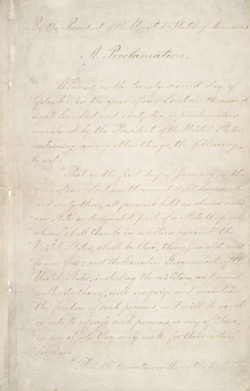Special Viewing Hours December 30, 2012 through January 1, 2013
Washington, DC, Nov 14, 2012: The National Archives will commemorate the 150th Anniversary of the Emancipation Proclamation with a free special display of the  original document from December 30, 2012 through January 1, 2013. The Emancipation Proclamation is displayed only for a limited time each year because of its fragility, which can be made worse by exposure to light, and the need to preserve it for future generations.
original document from December 30, 2012 through January 1, 2013. The Emancipation Proclamation is displayed only for a limited time each year because of its fragility, which can be made worse by exposure to light, and the need to preserve it for future generations.
The document will be on display in the East Rotunda Gallery of the National Archives Building, which is located on Constitution Avenue at 9th Street, NW, and is Metro accessible on the Yellow and Green lines, Archives/Navy Memorial/Penn Quarter station.
Viewing schedule for the original Emancipation Proclamation:
Sunday, December 30, 2012 – 10 a.m. –5 p.m.
Monday, December 31, 2012 – 10 a.m. – midnight
Tuesday, January 1, 2013 – 10 a.m.–5 p.m.
Watch Night Festivities, Monday, December 31, 2012
11:30 p.m. – Performance by Washington Revels Heritage Voices
Midnight – Bell ringing by Harriet Tubman, portrayed by historical re-enactor
Emancipation Proclamation Reading, Tuesday, January 1, 2013 at 9 a.m.
The first hundred guests in line at the main museum entrance at Constitution and 9th Street, NW, by 8:15 a.m. are invited to enter the building to experience the dramatic reading of the Emancipation Proclamation by Dr. Bernice Johnson Reagon, musician, song talker, and scholar.
Family Day Programming, Tuesday, January 1, 2013, 11 a.m. – 2 p.m.
- Hands-on family activities
- Storyteller Bill Grimmest portrays Frederick Douglass in “Tales of My Friend Mr. Lincoln”
- Historical re-enactors will portray Harriet Tubman, Abraham Lincoln and Rosa Parks.
About the Emancipation Proclamation
President Abraham Lincoln issued the Emancipation Proclamation on January 1, 1863, during the American Civil War, formally proclaiming the freedom of all slaves held in areas still in revolt. The issuance of this Proclamation clarified and strengthened the position of the Union government, decreased the likelihood of European support of the Confederacy and, as the Union armies extended their occupation of the southern states, brought freedom to the slaves in those states. The Proclamation invited black men to join the Union Army and Navy, resulting in the enlistment of approximately 200,000 freed slaves and free black people before the War’s end.
Although the Emancipation Proclamation did not end slavery in the nation, it placed the issue squarely on top of the wartime agenda. It added moral force to the Union cause and was a significant milestone leading to the ratification of the 13th Amendment to the Constitution in 1865, formally outlawing slavery throughout the nation.
The Emancipation Proclamation linked the preservation of American constitutional government to the end of slavery, and has become one of our country’s most treasured documents.
For information on National Archives public programs, call 202-357-5000, or view the Calendar of Events online.